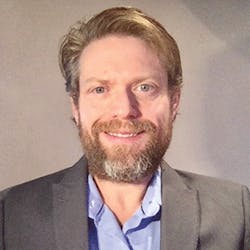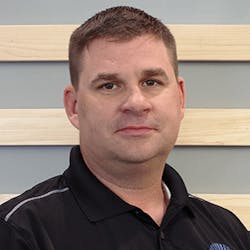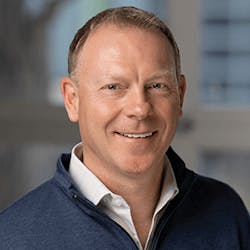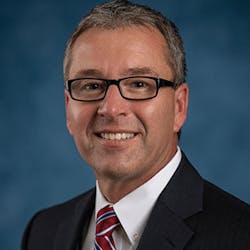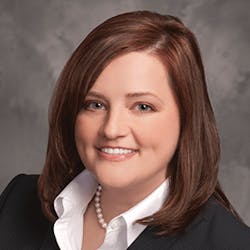Welcome 2022 ICT Visionaries
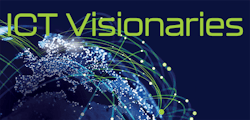
Visionary leaders are individuals who guide a team toward positive change. They may not be c-level execs or SMEs or professionals with many acronyms behind their names. In fact, they may be quiet thinkers, makers and doers who deliver on their promises without fanfare.
That’s why we are pleased to announce the 2022 ICT Visionaries who were eagerly nominated by their leaders and colleagues. They embody the important characteristics of true Visionaries and will share insights throughout the year to help you and your teams crush your 2022 goals.
Topic: Network-as-a-Service
IDC expects global enterprise network infrastructure spending to hit $45 billion by 2025, with about a third of that—$15 billion—NaaS-related. IDC comments, "Communications service providers (CSPs) are ideally positioned to deliver it but they need to act fast and be smart if they want a piece of the $15 billion NaaS opportunity." What network-related strategies or tools are needed to do this?Topic: Earth-Friendly Network
The Internet’s data may be invisible, but it requires physical data centers across the world that must be powered on, cooled, and protected 24 hours a day, 7 days a week. Similarly, the magic of 5G is impossible without base stations that can consume a lot of energy. For businesses committed to Environmental, Social and Governance (ESG) goals, reducing their carbon footprint will be key in achieving company-wide emissions targets. Share 2 of your favorite earth-friendly network-related strategies your company is instituting to help the ICT industry do more for the environment.Topic: The Great Resignation and 5G Labor Needs
It hit in 2021. It continues in 2022. What can providers do to keep and attract great talent to fill 5G network-related job positions?Topic: Fiber Frenzy
The global optical communication and network equipment market is expected to generate $23.6 billion by 2028. While fiber supply may not be a problem, there may be other factors that have potential to threaten this. Share your thoughts about this predicament and what it means for your company. Source: https://www.marketstudyreport.com/reports/global-optical-communication-and-network-equipment-market-2021-2028Topic: Smart Cities and Communications Service Providers/Telecom Providers
The smart city market is expected to grow 29% annually from 2021 to 2028. The future smart city will be driven by strategic collaboration between public and private organizations. What is your company doing in terms of network evolution in this area? Source: https://datacenterfrontier.com/flexentials-top-tech-predictions-for-2022/Topic: The Elephant in the Room
Forrester predicts that 85% of satellite users will be in rural locations, with remote worker initiatives and remote facilities benefiting significantly from satellite Internet in 2022. Some believe delivering 5G to the masses is a bit more challenging than providers are letting on—most of them relating to the infrastructure required for it. What are your thoughts about the "5G versus satellite elephant" in the room? How can telecom providers "win" this competition? Source: https://www.zdnet.com/article/digital-divide-shape-edge-iot-and-networking-in-2022/Johan Ottosson
Vice President Strategy
Arelion
Topic: Earth-Friendly Network
Short term, we minimize the impact of the energy we consume running our network. In regions such as the US, where we deploy our PoPs in large carrier-neutral data centers, we partner with those that share our goal and mission for sustainability. When we research and source colocation capacity, we select facilities that make efficient use of sustainable power, providing acceptable latency limits while sourcing low-cost electricity with a low carbon footprint. However, we also need to change the game itself. Relying on the builds of the past—with legacy platforms, operational paradigms, and tools—will fall short not only meeting in bandwidth requirements, but also lead to unacceptable power consumption. By taking the lead in introducing next generation routing silicon, open optics, and open line systems, we found ways to reduce power consumption of 80-90% per bit with 80% success within our IP domain transition. We have set an ambitious migration plan that will retire 8 different platforms by 2025.Topic: Network-as-a-Service
Service providers need to start with the right commercial model, offering commercial flexibility and transparency for network buyers to understand expected charges. Unlike the Cloud, where costs can quickly spiral out of control, most network buyers prefer predictability and control. Beyond the assets and tools to secure sufficient capacity for unexpected surges in demand, service providers need to excel at customer experience way beyond the initial purchase. They need to put network managers one step ahead of their stakeholders by providing access to critical data, intuitive analytics, and continuous support, that also integrates their insights of their networks and ecosystems and the capabilities of its existing service assurance organizations. As this requires auto-provisioning systems based on real-time accurate inventory data, and sophisticated portals or API-able network functions or datasets, service providers need to keep NaaS simple. We believe that basic things, like prices that unbundle access charges from services, software-driven service activation, and a great API-based portal, goes a long way.Topic: Fiber Frenzy
In 2021, the global semiconductor crunch impacted network equipment vendors worldwide, leading to fulfillment issues and long lead times across the telecom industry. While this crisis is set to ease in the coming year, there is a more long-term threat, as the US fiber market is becoming increasingly consolidated, particularly on the long-haul. This situation is starkly different from Europe, where multiple providers compete across all major markets. By lighting new fiber routes and bringing more data centers on net, we have brought more competition into the US market, helping customers secure their needs for capacity, diversity, and cost-efficiency. Further consolidation of fiber assets from the remaining independent dark fiber providers would work in the opposite direction, to the detriment of enterprises, consumers, and digital service providers.BIOGRAPHY: Johan’s career is founded on two things: curiosity and exploration. As an experienced strategist and manager, he led the development of growth strategies, M&A, and long-term corporate strategic planning across various industries, before zeroing in on communications and technology. He believes that a firm commitment to innovation is the key to staying competitive. Experience has taught him that innovation is not defined by organizational charts and that many of the best ideas come from those working with customers or engineering the network. https://www.linkedin.com/in/jottosson/
Formerly Telia Carrier, Arelion is a leading light in global connectivity services. We’ve been keeping the world connected since 1993 and today our global IP backbone, AS1299, is ranked number one in the world. Our network spans Europe, North America, and Asia with 70,000 km of optical fiber and 1,700 MPLS endpoints. Our award-winning customer service team supports our expansive customer base, who rely on us for their business-critical services. Follow us on LinkedIn: https://www.linkedin.com/company/arelion and Twitter: https://twitter.com/ArelionCompany. www.arelion.com
Brooks Fitzsimmons
Assistant Vice President, Transformation,
AT&T Technology Services
AT&T
Topic: Network-as-a-Service
AT&T started their journey to network-as-a-service by encouraging the supplier community to separate the software from the hardware layer. The industry has seen a remarkable growth in white box solutions wherein distinct network functions can be service chained together in new/novel approaches. Meanwhile, the scaled cloud community has realized the benefit of low latency, 5G connectivity and have engaged with the CSPs to push computing to the edge. These 2 complementary capabilities will let the joint community create new/novel products and services that can be turned on/off based upon network conditions, user demands, and device capabilities (e.g., AR/VR).Topic: The Great Resignation and 5G Labor Needs
ICT companies are facing an existential crisis with human capital that includes the "Great Resignation" but is actually amplified by the fundamental shift away from custom/bespoke applications and hardware to common, consistent software-configurable network assets and software as a service platforms. Companies are realizing the benefits of SaaS and software-centric network elements: total cost of ownership savings, work center efficiencies, end-consumer experience improvements, and business risk management. However, this comes at a cost of labor/technology stack "homogenization". The labor elasticity of developers coding in common "modules" and "platforms" fundamentally is becoming a double-edged sword. It will be critical to establish robust and ongoing training, pipelines into the colleges/universities, and public policy initiatives that incentivize skills pivots to maintain and grow the labor pipeline. Lastly, it will be critical for software platform providers to evolve low-code/no-code and AI/ML-driven software development to reduce the manpower involved in operating and developing on these capabilities.Topic: The Elephant in the Room
Programs like the FCC’s Universal Service have played a critical role in helping millions of Americans get access to and make the communication tools they need more affordable. Policymakers must ensure that these programs, which include the Connect America Fund (CAF), Lifeline, Schools and Libraries (E-rate) and Rural Health Care, are continually updated to reflect the ever-changing marketplace and needs of consumers. As such, we should not consider the notion of "5G vs. satellite", an either/or scenario. At the most basic level, we should look at radio technologies (terrestrial, LOE, or geostationary) as the access "on-ramp" that most expeditiously leads customers to their end-state connection point. That is ultimately achieved by either pushing services as close to that edge as possible, (e.g., edge compute technology) or pushing fiber as close to the edge of that radio connection to maximize fiber’s dense and fast physical properties.BIOGRAPHY: Brooks Fitzsimmons manages the division responsible for the ServiceNow Platform strategy, standards, and Operations for AT&T. By shifting dozens of individual inventory systems into a consolidated configuration management database, the ServiceNow team will deliver one of the largest, horizontal "single sources of truth" for AT&T. This consolidation will enable lower TCO, improved operating efficiency, better end-customer cycle times, and improvements into the risk management (cyber and business continuity) posture of AT&T. Follow Brooks on LinkedIn: https://www.linkedin.com/in/tbfitzsimmons.
AT&T Inc. (NYSE:T) is a diversified, global leader in telecommunications, media and entertainment, and technology. AT&T Communications provides more than 100 million US consumers with communications and entertainment experiences across mobile and broadband. Plus, it serves high-speed, highly secure connectivity and smart solutions to nearly 3 million business customers. Warner Media is a leading media and entertainment company that creates and distributes premium and popular content to global audiences through its consumer brands, including HBO, HBO Max, Warner Bros., TNT, TBS, truTV, CNN, DC Entertainment, New Line, Cartoon Network, Adult Swim and Turner Classic Movies. AT&T Latin America provides wireless services to consumers and businesses in Mexico. www.att.com.
Kevin Tusing
Application Engineer
Clearfield
Topic: Network-as-a-Service
When considering NaaS, focus on the priority to better support remote work from home employees as a networking strategy. Fiber is the most effective way to provide customers with an efficient work from home network. The most time-consuming and expensive part of the network to build is from the OLT to the ONT. But Clearfield’s YOURx® platform is focused on driving down network turn up time and labor costs while easing the design for those looking to engineer and build the infrastructure. Rapid planning with focus on the future will need to be balanced with short term opportunities.Topic: Fiber Frenzy
This is a dynamic challenge. There are shortages in materials and qualified labor—a problem exacerbated by the pandemic. Operators will need to move quickly to hire or contract personnel and work with them to provide the training necessary to perform efficiently. But the days of lengthy training periods over a diverse collection of products and processes are gone. Focused training on specific materials and related processes needs to be developed.On the materials front, operators will need to develop closer partnerships with distributors and suppliers. Operators will need to make some compromises based on materials and products available. This will also affect some of the processes required to engineer and install these products. There are many qualified suppliers out there and one of the biggest factors to consider is the lead time for products to be on site and ready for deployment. Customized solutions will not be an option in many cases. Engineering needs to be focused on applications for available products and not engineering new products to fit the application. These compromises and shortages will also drive the labor training requirements mentioned above. Detailed planning is especially important. Clearfield has been able to satisfy many operators’ needs by offering fiber network products and training. Clearfield product lead-times have kept up with demand better than most, and as such, we have gained new customers.
Topic: Smart Cities and Communications Service Providers/Telecom Provider
Clearfield has a history of working closely with providers and customers to fulfill their needs. Clearfield is already providing many innovative fiber optic connection products related to Smart City strategies. We intentionally listen to these customers to keep up with the fiber needs for both the public and private sector.BIOGRAPHY: As a Clearfield application engineer, Kevin Tusing leverages his extensive experience in network design, OSP engineering, communication technology, fiber optic systems and field operations. Prior to joining Clearfield, he spent over 2 decades in the US Air Force and ANG as a Senior Non-Commissioned Officer leading teams in various telecommunication engineering and installations around the world. Kevin also spent 15 years at Cincinnati Bell telephone working as a cable splicer and then manager.
Clearfield is Enabling the Lifestyle that Better Broadband Provides by removing the barriers to rapid fiber deployments.
When it comes to distribution, consolidation, management and protection of fiber, nothing comes close to Clearfield’s streamlined, practical approach. With labor lite technologies and products designed for scalable deployment, craft-friendly operation and unsurpassed performance, Clearfield innovates to reduce your pre-engineering and skilled labor requirements while delivering the lowest total cost of ownership.
Whether you’re delivering fiber-to-the-business, home, or cell site, Clearfield has the flexibility to deploy the product platform for your entire range of applications. www.SeeClearfield.com
Ryan Korte
Senior Director, Edge Computing
Lumen
Topic: Earth-Friendly Network
As Lumen designed and implemented our Edge Compute infrastructure, which in some cases includes smaller facilities where power and cooling are often a luxury, we focused heavily on power consumption and equipment cooling.Many of us were taught an important principal by our parents at an early age: turn the lights off when you leave the room. Our approach is no different in that all our compute equipment, when not in use by our customers, is fully powered down until requested. This adds time to the delivery for compute resources as the power-on checks need to occur before we can deliver to our customers. We know it is good practice and needs to occur.
Also, we are working with our hardware manufacturers to optimize and utilize all power saving options available with no impact on customer performance. Within our compute network, this can include reducing processors, reducing processor speeds, shutting down drives when not in use, and many other options. We continue to provide input to our vendor partners to improve and expand on these capabilities.
Topic: Fiber Frenzy
Not all fiber is created equal. The market for optical hardware and the capabilities for new hardware to drive higher speeds and more wavelengths on a single fiber will continue to advance. As we continue to build global fiber networks and entire systems, we need to think about 2 major areas.First, the physical plant. There are some areas like rain forests, mountain regions, and subsea, where we need to determine how to maximize in place assets that may be less capable than newer systems. We need to continue to build new fiber where we can, but we can’t strand these hard to replace assets until we’ve built new ones, and that will take some time.
Second, we need to continue to think about how we fully utilize these assets. In all cases, we need to automate the provisioning, but we should first use that automation to optimize fiber assets in constrained locations and eventually replicate that to less constrained areas to ensure we have a path to keep up with the growing market demand.
Topic: Smart Cities and Communications Service Providers/Telecom Providers
Lumen has made and continues to make a big investment in our Edge Compute platform, which includes pushing this infrastructure within 5 milliseconds of our end customers. Smart cities will need to be local, and we believe the combination of compute and network in these cities is critical to building smart infrastructures that support real-time, low-latency data communication between all organizations and individuals in that local market.BIOGRAPHY: Ryan Korte has more than 26 years of experience in developing and managing advanced fiber-optic network and systems architecture for both Fortune 500 enterprise companies and nationwide telecommunications carriers. In Ryan’s current position, he and his team are responsible for the Lumen Cloud Connect product with connections to all major cloud service providers, 2,200+ public and private data centers, and over 160,000 fiber-enabled on-net buildings.
Lumen is guided by our belief that humanity is at its best when technology advances the way we live and work. With approximately 450,000 route fiber miles and serving customers in more than 60 countries, we deliver the fastest, most secure platform for applications and data to help businesses, government and communities deliver amazing experiences.
Learn more about Lumen’s network, edge cloud, security, communication and collaboration solutions and our purpose to further human progress through technology at news.lumen.com, LinkedIn: /lumentechnologies, Twitter: @lumentechco, Facebook: /lumentechnologies, Instagram: @lumentechnologies and YouTube: /lumentechnologies. Lumen and Lumen Technologies are registered trademarks of Lumen Technologies, LLC in the United States. Lumen Technologies, LLC is a wholly-owned affiliate of CenturyLink, Inc. www.lumen.com
Wade Soczka
Director of Network Construction
TDS Telecom
Topic: Fiber Frenzy
One could argue that availability of fiber optic cable is of concern right now. The industry is seeing longer lead times with fiber and other critical materials such as aboveground pedestals, below-grade vaults, and splicing enclosures. To mitigate this risk, our company provides long-term material forecasting to supply chain partners to maintain a level of available stock for contractors to place incremental orders as needed. In addition, there is a nationwide shortage of resources to construct and splice fiber optic networks. Subcontractors tend to be nomadic and pivot to a master contractor willing to pay higher per unit pricing. Incumbent providers over lashing fiber on existing copper/coax networks and new entrants’ attachments introduce risk of pole loads issues. If there is makeready required by the pole owner, it may increase costs and slow progress. To mitigate, a pole viability protocol is used during fielding to identify possible issues and pivot to underground to avoid delays.Topic: Smart Cities and Communications Service Providers/Telecom Providers
TDS Telecom’s focus is overbuilding chosen communities with a robust and future-proof fiber optic network. Active nodes are strategically placed on transport rings for survivability along with dual/redundant feeds from the market to the outside network. Transforming communities does not come without disruption and coordination. Many local jurisdictions do not have staff to handle permitting, locating, and inspection tasks in support of builds thus slowing progress. While our goal is not to build entire smart networks, we often forge strategic partnerships with local communities, helping each other build networks in support of respective goals.Our fiber-based product offerings may be desirable to a community partner when attempting to connect locations on an internal network and/or high-capacity broadband services. In some cases, the opportunity presents itself to exchange fiber and/or conduit or work together on joint trench opportunities. Communities can then achieve needed fiber connectivity to substations, satellite building locations, well sites, etc. In exchange, it provides our company opportunity paths in existing community-owned facilities, mitigating the need for burdensome construction.
Topic: The Elephant in the Room
While not an area of expertise for our organization, we keep a finger on the pulse of 5G and satellite providers as legitimate competitive threats. Rural areas pose a challenge for 5G as a certain amount of physical infrastructure is required to support small cell sites. The cost of building such networks in a rural area with lower density may prove uneconomical in some cases. And, while satellite can mitigate that risk, there are still latency and disruption impacts to their level of service. A fiber optic cable between core network gear and the home is still the tried-and-true method of mitigating wireless and satellite throughput challenges.BIOGRAPHY: Wade has been with TDS Telecom for nearly 30 years, beginning as a network technician. He currently oversees the successful deployment of fiber-to-the-home in out-of-territory markets. He provides leadership to internal outside plant construction, route acquisition, and colocation teams, as well as 4,000+ external contracted resources supporting builds in 40+ municipalities across 5 states. He earned a Bachelor of Business Management and an MBA from Herzing College and his associate degree from the Wisconsin School of Electronics.
TDS Telecommunications, LLC (TDS Telecom/TDS®) delivers high-speed Internet, TV entertainment, and phone services to more than 1,000 rural, suburban, and metropolitan communities across the US. With 1.2 million connections, TDS is a rapidly growing technology company. Powered by fiber optics and new industry-leading technologies, TDS delivers up to 2 Gigabit Internet speeds and offers Internet protocol-based TV entertainment solutions along with traditional phone services. TDS also offers businesses VoIP advanced communications solutions, dedicated Internet service, data networking, and hosted-managed services.
TDS Telecom, headquartered in Madison, Wisconsin, employs 3,000 people and is a subsidiary of Telephone and Data Systems, Inc. (NYSE: TDS), a Fortune 1000® company. Founded in 1969, Telephone and Data Systems provides wireless, broadband, video, and voice, as well as hosted and managed services to approximately 6 million connections nationwide through its businesses: UScellular, TDS Telecom, and OneNeck IT Solutions. www.tdsinc.com and www.tdstelecom.com
Noah Drake
Vice President, Customer Solutions and Architecture, Americas
Telstra
Topic: The Elephant in the Room
The best approach is to view this "competition" as potential opportunities. More connectivity benefits everyone—especially as worldwide demand for connectivity is surging to the point where on some key routes, there’s a genuine capacity shortage. It’s critical that service providers such as Telstra continually invest in new types of infrastructure. Satellite operators are seizing opportunities to expand their global footprint; however, satellite services still rely on telcos for ground stations and transport, and operators regularly face barriers to market entry. These issues are often best addressed through mutually beneficial partnerships with telcos.Topic: The Great Resignation and 5G Labor Needs
As a telecommunications company, we are constantly focused on investing in our networks to grow revenue. But it’s equally important to ensure we continually invest in our people, too. We can’t begin to talk about attracting and retaining top talent without first addressing workplace culture. Employees want to know they are doing work that makes a difference and truly has an impact on people’s lives. That opportunity not only creates an incredible sense of empowerment, but it’s also a powerful recruiting tool. Candidates now have more say in deciding where and how they want to work, so the onus is on organizations to reevaluate the type of workplace they want to offer.It’s up to our entire team, starting with leadership, to commit to ongoing learning, training, and professional development. That’s how you keep your business relevant, dynamic, and thriving.
Topic: Network-as-a-Service
We’re all used to online subscription models, whether it’s for a streaming service or food delivery. We enjoy the control and ability to manage them according to our needs. It’s getting to be the same with enterprise network infrastructure and bandwidth.Thanks to new software-based technologies more suited to today’s adaptive networking needs, organizations are no longer limited to inflexible, costly, and time-consuming options involving monthly service provider contracts and large IT support teams. It’s now possible to meet users’ modern technology expectations and create network infrastructures enabling flexibility, efficiency, lower unit cost and scalability—all while being simple enough for users to manage themselves. They easily scale bandwidth up or down, or for certain time periods, on a customized network designed to integrate with open-source cloud environments and also built with the latest and most popular applications in mind.
But this all begins with a shift in mindset and an open attitude to change. The technology world is evolving, and we all need to either adapt or risk becoming irrelevant.
BIOGRAPHY: Noah leads the company’s Customer Solutions and Architecture group for the Americas region. He oversees a specialized team that works with customers to create value by bringing together the full capabilities of Telstra’s products and services. Based in Denver, Noah is also a member of the company’s Americas leadership team. He has more than a decade of experience in the international communications space, building best-in-class performing teams and aggressively scaling in high growth environments.
Telstra is your partner to connect purposefully to new growth in Asia and beyond. Today, they have approximately 1,600 employees based in more than 20 countries outside of Australia, providing services to thousands of customers. They offer those customers the largest and most diverse intra-Asia subsea network system, established over several decades and which delivers approximately a third of Asian IP traffic. These services are underpinned by their extensive cable network, with licenses in Asia, Europe and the Americas and access to more than 2,000 Points of Presence (PoPs) in more than 200 countries and territories.
Telstra’s heritage is proudly Australian with over 70 years’ experience of helping international businesses connect. They operate in every major market and have an unparalleled network and presence in Australia and Asia Pacific. Follow Telstra on LinkedIn: https://www.linkedin.com/showcase/telstra-enterprise and Twitter: https://twitter.com/TelstraEnt. www.telstra.com/americas
Mary Nolan
Executive Director – Network Assurance
Verizon
Topic: The Great Resignation and 5G Labor Needs
Verizon is offering a new program called Verizon Skill Forward for both internal employees and individuals looking to gain knowledge that would help catapult their career in IT. It is a free virtual bootcamp that provides technical and soft skills training for high-demand technology careers.In addition, Verizon has the distinguished honor of being a 2021 Military Friendly® top company for our commitment to recruiting, supporting, and developing military talent. With our competitive benefits, commitment to upskilling our workforce and our increasing use of automation, we are well positioned to attract and keep great talent.
We also launched the Moment to Movement initiative within our technology organization to reevaluate how we attract, recruit, develop and retain talent, specifically focusing on black and POC individuals as well as those from non-traditional backgrounds. Part of that program has included reevaluating the language and requirements of our job descriptions, focusing more on finding candidates with the applicable skills who might not otherwise apply.
Topic: Earth-Friendly Network
In February 2019, Verizon announced the close of the US telecommunications industry’s first Green Bond. This bond will be used to fund a variety of new and existing green initiatives supporting Verizon’s long-term commitment to minimize its environmental impact, drive operating efficiencies and benefit the communities it serves.Our focus is on renewable energy, energy efficiency, green buildings, sustainable water management, and biodiversity and conservation designed to positively impact the environment and advance U.N. Sustainable Development Goals. In addition to the focus on reducing our environmental footprint, we also made a commitment to plant 2 million trees by 2030.
As of September 2021, Verizon settled our third green bond of $1 billion. In the span of 2 years, Verizon has become one of the leading corporate buyers of renewable energy in the US, entering into 14 virtual power purchase agreements for nearly 1.9 gigawatts of renewable energy capacity.
Topic: Smart Cities and Communications Service Providers/Telecom Providers
Verizon has been building out fiber optics in cities around the United States to support the technology that will be used in the next generation of connected cities.Our deployment of 5G Ultra Wide Band complemented by our C Band spectrum will enable cities to leverage more possibilities for enhanced services within their communities.
We are providing faster speeds, more capacity and reduced latency which will be critical as cities transform into high-tech smart cities.
BIOGRAPHY: The Network Assurance team is accountable for the reliability, performance, and security of Verizon’s Wireless network. Mary’s team of experts monitor and manage the various networks and applications that are the foundation for Verizon Wireless’s consumer and business services. More specifically, the team is responsible for managing the Verizon Wireless radio access, transport / IP networks and customer experience. Contact Mary at [email protected] and follow her on LinkedIn: https://www.linkedin.com/in/maryfiocco.
Verizon Communications, Inc. was formed on June 30, 2000, and is one of the world’s leading providers of technology and communications services. Headquartered in New York City, and with a presence around the world, Verizon generated revenues of $128.3 billion in 2020. The company offers data, video and voice services and solutions on its award-winning networks and platforms, delivering on customers’ demand for mobility, reliable network connectivity, security, and control. www.verizon.com
About the Author
Sharon Vollman
Content Ambassador for ISE EXPO
Sharon Vollman is the Content Ambassador for ISE EXPO. She is passionate about collaborating with thought leaders, SMEs and hard-working doers who design, plan and deploy ultra-reliable broadband networks. Vollman is committed to creating a variety of educational offerings for ISE EXPO attendees that inspire them to connect every U.S. citizen with the broadband networks we all want for our children and grandchildren.
Vollman has created educational partnerships with Broadband Service Providers including AT&T, Verizon, Lumen, Frontier Communications and others. She has covered the telecom industry since 1996.


